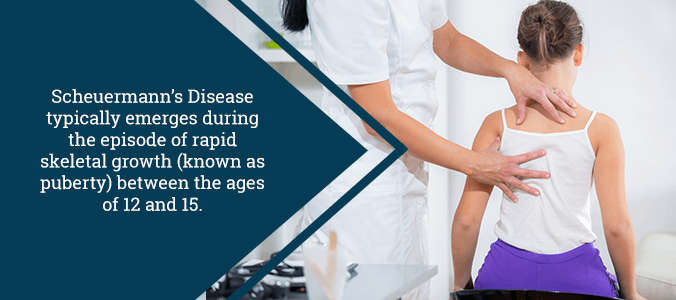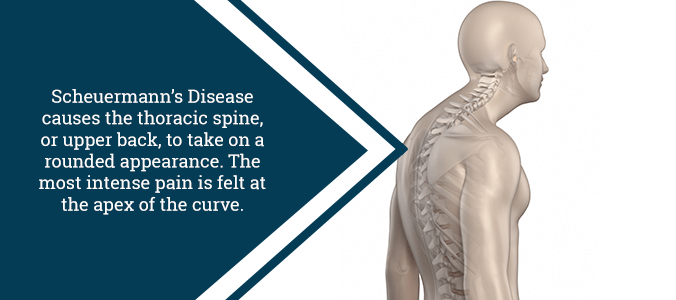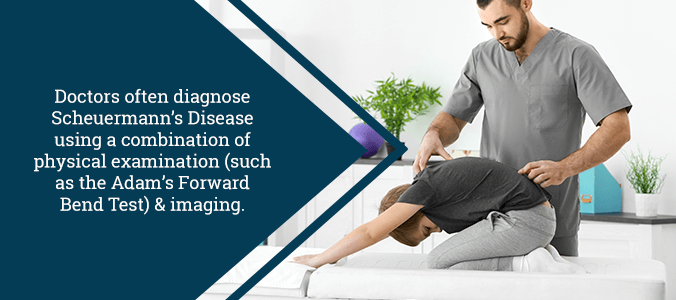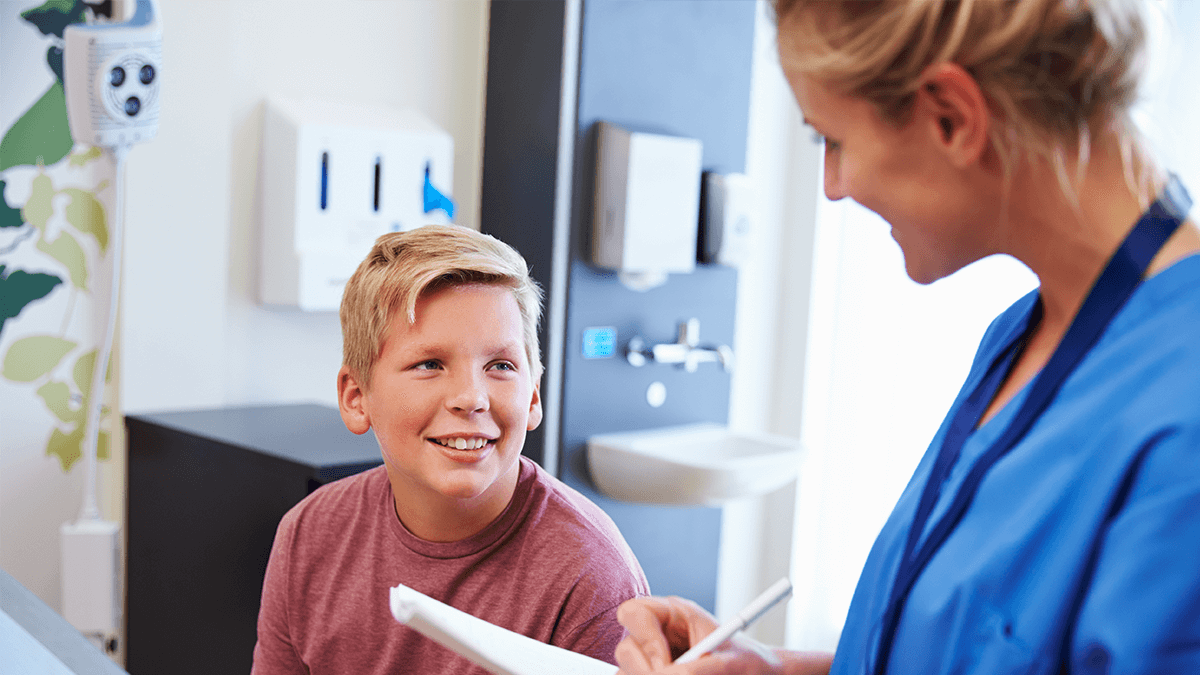What is Scheuermann’s Disease?
A normal, healthy spine contains a set of natural curves. When you look at a healthy spine from the side, you should be able to see these gentle arcs. That being said, too much curvature along the mid-back is problematic. This leads to a condition known as kyphosis.
One subtype of kyphosis is Scheuermann’s kyphosis, which people sometimes refer to as Scheuermann’s disease. In the early 1920s, a Danish radiologist (after whom the condition was named) first discovered the disorder. Wedge-shaped vertebrae define this condition, which causes the thoracic spine to curve forward more than it should.
Typically speaking, Scheuermann’s kyphosis develops during episodes of skeletal growth (such as during puberty). In fact, the condition occurs when the anterior side of the spine does not grow as quickly as the posterior side. This is what leads to the irregular, wedge-shaped vertebrae that cause the forward curvature of the spine in patients with this condition.
This disorder most commonly occurs between the ages of 12 and 15 and it almost always manifests in the thoracic spine. That being said, there have also been cases in which the condition first arose in the lumbar spine. Although the precise cause of Scheuermann’s disease remains unknown, researchers suggest that genetics play a role.

The Anatomy of the Spine
Understanding the anatomy of a healthy spine will help you to better understand the nature of Scheuermann’s disease.
Your spinal column begins at the base of the skull and terminates near your pelvis. This column contains 33 vertebrae with spongy, disc-like material sandwiched in between each bone. These structures help to absorb and distribute shock, while also acting as a natural lubricant during movement. Furthermore, healthy vertebrae are rectangular in shape (not wedge-like in appearance) and neatly stack on top of one another.
A healthy spine has some degree of natural curvature from the front to back. However, for some patients, the thoracic spine may curve up to 40 degrees or more. This gives these patients the appearance of having a humpback or hunchback. In some cases, the head may appear to pitch forward and rest on the chest (known as chin-on-chest syndrome). This is what a spine with kyphosis looks like to the outside observer.

Signs & Symptoms of Scheuermann’s Disease
Scheuermann’s disease is mostly found in teenagers and typically manifests as a much worse deformity than postural kyphosis. Patients suffering from Scheuermann’s disease, for example, cannot voluntarily correct their posture. This is because the apex of the unnatural curve in the thoracic spine is very rigid.
The disease is well known for causing lower and mid-level back pain, which ranges from extremely severe to downright disabling. Additionally, patients with Scheuermann’s disease may feel pain at the apex of the unnatural curve, which only worsens with physical activity or periods of prolonged sitting/standing. These elements have severe impacts on the patient’s quality of life, limiting the ability to perform everyday activities. Furthermore, because this disease typically affects children and teens, patients with severe physical deformities may find themselves ostracized by their peers.
In addition to pain, many patients with this condition experience a loss of vertebral height. In more extreme cases, there may also be a visual hunchback or round back. Currently, it is known that curves in the lower thoracic region cause more pain, whereas abnormal curves in the upper portion of this region present a more observable deformity. Either way, most patients will seek treatment either for the pain or for the visual deformity that Scheuermann’s disease can cause.
Lastly, the most common thoracic vertebrae that the condition affects is the seventh and tenth (or T7 and T10). When Scheuermann’s kyphosis affects these structures, it leads to both backache and unnatural spinal curves. In the most serious of cases, this condition may also lead to internal problems and long-term damage to the spinal cord. Luckily, these cases are extremely rare.
Conditions Associated with Scheuermann’s Disease
Many patients with Scheuermann’s kyphosis will also often have unnatural lordotic curves in the lower spine. This is the body’s natural response to compensate for the kyphotic curves that manifest from the condition. Additionally, many patients with this condition have larger lung capacities, as well as broader chests. Researchers suggest that this is simply another natural response from the body to compensate for the loss of breathing depth.
It is also common for patients with this condition to have tight hamstrings, which is another compensatory response for excessive kyphotic curves. Some suggest, in fact, that the tightness of these muscles is what leads to Scheuermann’s disease. In addition to associated lordosis, experts have also observed that 20-30% of patients with this condition have scoliosis. In the most serious instances, doctors categorize this condition as something completely separate—kyphoscoliosis.

Scheuermann’s Disease Diagnosis
The diagnostic process for this condition is broken down into physical examinations and imaging tests. Usually, physical examinations are performed first, with imaging tests following up for confirmation. Here are a few examples of physical examinations that doctors use to diagnose Scheuermann’s kyphosis:
- Palpation: Basically, a hands-on examination that helps to determine spinal deformities through touch. When the disease is present, the thoracic area of the spine curves excessively forward.
- Adam’s Forward Bend Test: Another basic test in which the doctor simply asks the patient to bend forward at the waist. If present, this will reveal thoracolumbar kyphosis.
- Range of Motion: This is exactly what it sounds like. The doctor tests the patient’s ability to bend forward, back, and side-to-side.
After the doctor performs one or more of these examinations, he or she usually will follow up with an x-ray imaging test. Your doctor will perform these tests to confirm the severity of all curves that present.
Scheuermann’s Disease Treatment
As with most conditions, the treatment for Scheuermann’s disease breaks down into two major categories: conservative and minimally invasive.
For less extreme cases, your doctor will push for a more conservative route. This includes treatments such as manual medicine, physical therapy, and/or back braces. All of these methods help to reduce the severity of the condition and prevent it from progressing. Usually, the disease itself is rather benign and does not require surgery. Of course, that isn’t to say that there aren’t cases in which surgery is the only effective plan of action.
Surgical treatments almost always include spinal fusion and some implantation of hardware (rods, pedicle screws, etc.). It is important to understand that surgery focuses more on treating pain than fixing cosmetic defects. As always, you should only consider surgery as a last resort as it inherently carries more risks.
Contact Us
If you have a spinal deformity that causes discomfort or even just a cosmetic defect, please contact our practice at (855) 220-5966. Dr. Jason E. Lowenstein is a leading expert in the field of spinal deformity care. He will work tirelessly to ensure that you receive a personalized treatment plan that best suits the specific needs of your case.
